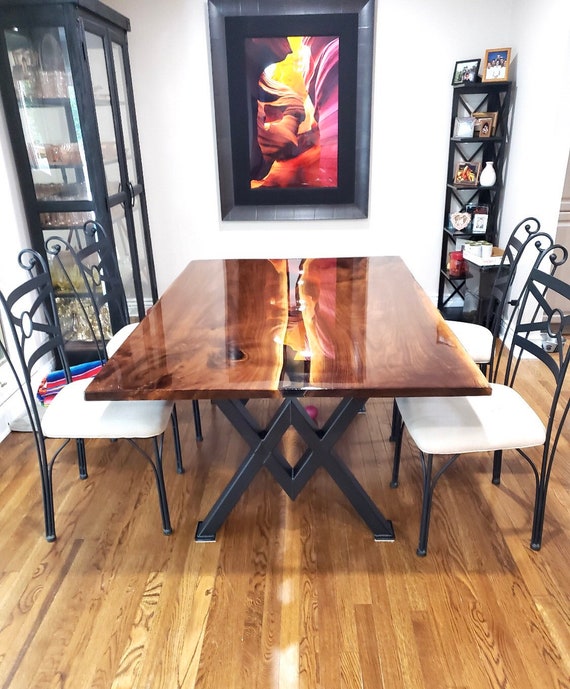Why Custom Dining Room Table Legs Are Worth the Investment
Why Custom Dining Room Table Legs Are Worth the Investment
Blog Article
Professional Tips for Setting Up Dining-room Table Legs for Maximum Stability
When it comes to installing eating area table legs, accomplishing optimum stability is paramount for both performance and looks. What particular techniques can enhance stability also additionally?
Choose the Right Legs
When selecting the suitable legs for your dining-room table, it is necessary to think about both performance and aesthetics. The legs you select will considerably influence the overall style and security of the table. Initially, examine the table's planned usage; if you anticipate frequent celebrations, sturdier legs, such as those made from solid wood or steel, might be more appropriate, as they supply enhanced durability and support.
Conventional eating tables normally range from 28 to 30 inches in height, so guarantee the legs align with this standard for convenience. Tapered legs can add a modern touch, while turned legs might communicate a much more traditional aesthetic.

Select Appropriate Equipment
Just how can the appropriate hardware improve the security and longevity of your dining-room table? The option of proper equipment is important to making sure that the legs of your table are safely connected and able to withstand routine usage. Top quality screws, bolts, and brackets provide the needed strength to sustain the weight of the table, in addition to any type of extra loads placed upon it during meals or events.
When selecting screws, go with those made from long lasting materials such as stainless-steel or brass, which withstand corrosion and maintain stability in time. The length of the screws is similarly vital; they must penetrate deeply right into the table's structure without endangering integrity. For bolted links, take into consideration making use of lock washers to stop loosening as a result of resonance or motion.
In addition, utilizing corner braces can add extra assistance, particularly for larger tables or those with heavier tops. These brackets distribute weight equally and aid maintain the table's shape. Making certain that the hardware you choose is ideal for the details products of your table will certainly even more enhance its total stability and long life, allowing you to enjoy your dining experience for several years to find.
Ensure Correct Positioning
Correct alignment of dining-room table legs is necessary for both visual charm and useful security. Misaligned legs can lead to an unequal table top, which might not only be visually uninviting but additionally compromise the table's usability. To attain optimum placement, begin by gauging the distance from the table's corners to the leg add-on points. This guarantees that each leg is positioned equidistant from the edges, developing a balanced appearance.
Utilize a level during setup to confirm that each leg is perpendicular to the tabletop. It is suggested to mark the wanted leg site web positions on the bottom of the table with a pencil or covering up tape before securing them.
Additionally, double-check the positioning after the preliminary screws are tightened up, as adjustments may be necessary prior to fully safeguarding the hardware. By focusing on proper positioning, you not only enhance the table's overall style but likewise guarantee that it remains functional and steady for years ahead.

Think About Weight Distribution
After guaranteeing correct placement of the dining area table legs, it is necessary to consider weight distribution to improve security and performance. dining room table legs. Correct weight distribution is critical in avoiding making certain and wobbling that the table can sustain its desired load without risk of tipping or falling down
When placing the legs, ensure they are placed at equivalent ranges from the center of the table to uniformly distribute the weight across the structure. Take into consideration the weight of the table top and any type of things that will frequently hinge on it, such as tabletop devices or attractive pieces. Tables with heavier surfaces must preferably have legs located closer to the edges, as this maximizes the base of assistance and reduces the danger of instability.
Furthermore, if the table is planned for usage in a high-traffic area, think about making use of larger products for the legs or site here adding stabilizing aspects, such as cross-bracing or a reduced rack - dining room table legs. These changes can assist keep balance and prevent shifting throughout use. Inevitably, a well-considered weight circulation strategy will substantially enhance the table's total efficiency, guaranteeing it continues to be a attractive and useful focal point for your eating room
Examination Stability Before Use
Evaluating the stability of the eating room table before usage is a crucial step that must not be ignored. If the table reveals instability, determine the legs or joints that might need change.
Following, inspect that all bolts and screws are tightened up correctly. Loose links can lead to instability and possible damages over time. If needed, use wood adhesive on joints to improve security, making sure to allow sufficient drying out time.

Conclusion
To conclude, the installation of eating area table legs needs mindful consideration of products, alignment, weight, and equipment circulation to attain maximum stability. By picking sturdy legs and top quality bolts, guaranteeing precise positioning, and dispersing weight evenly, the structural stability of the table can be dramatically improved. Performing a stability test before regular use even more makes certain that the table will withstand daily stress, therefore providing a trustworthy and safe eating experience.
When it comes to mounting eating space table legs, attaining optimum security is extremely important for both functionality and visual appeals. The legs you select will substantially affect the general layout and stability of the table (dining room table legs). Standard dining tables typically range from 28 to 30 inches in height, so make sure the legs line up with this criterion for convenience.Appropriate placement of eating area table legs is crucial for both visual charm and useful stability.In final thought, the setup of dining room table legs requires mindful factor to consider of products, weight, equipment, and alignment circulation to accomplish maximum stability
Report this page